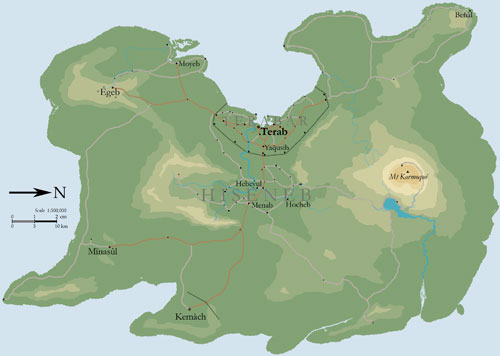Antyok

NB Antyok and Besoa follow the old custom of placing North to the right
Princedom of Antyok, (arch.) Heronbaht Principality of Ahntyok |
|
Large island due east of the island of Besoa, separated by the Hornbre (or Heronbar) Sea, at approx 42 o N/13 o YE |
|
c. 1800 km2 |
|
Warm maritime in the south; the mountainous north is often covered with cloud and volcanic vapour. |
|
The island is volcanic and dominated by a huge volcano, Mt Karmoqué, called by the native people the 'God Mountain'. The northern half of the island is a bleak rocky environment, particularly around the slopes of the mountain which are rugged lava-fields shattered into scree by earthquakes, thick with virid vegetation which thrives in the mineral-rich volcanic soil. Only the coastal fringes of the north are green. The northeastern region, in the shadow of the mountain, is the main refuge of the indiginous tribespeople, displaced from the south centuries ago. It is a grim environment, cloud-covered and fed by sulphurous rivers. The western coastline is dominated by a bay of deep water with precipitous volcanic cliffs. At its midpoint is a massive natural harbour, and the site of the main city, Terab (or Teraq, San.). The city and its immediate hinterland are surrounded by a massive series of earthworks and high stone walls, built to protect the early settlements and farmlands from native raids. The walls follow natural ridges, enclosing an area of approximately 160 km2 . East of Terab lies the central valley of the island, which is sheltered, well drained, and with its volcanic soils is the most fertile farmland in the entire Natorn archipelago. Agriculture is an important industry. Antyok exports staple foodstuffs to many neighbouring isles. The south coast has a very long sandy shoreline, with fishing villages and summer residences of the nobility, including the Summer Palace of Minasul. The southeast hills of Egeb (Egaith) have mines extracting iron and copper. It is the main industrial centre, producing iron and bronze. |
|
Approx 400,000 plus uncounted natives |
|
Feudal Principality. Hexact doctrine has never seriously influenced the island, and the state is a traditional monarchy headed by a Prince who rules with the aid and advice of a council of chief nobles and landowners. |
|
| Terab (also called Teraq) | |
The Tane, or Hook, a short hooked silver rod. This curious currency was devised in Heronbar long ago, the hook being a means of hanging the metal in a balance, ensuring purity in transactions. Foreign gold and silver coins are generally accepted in Terab, but for practicality they are often melted down by local silversmiths. |
|
| c. 3100 HM. Antyok officially uses the ancient Heronbaht calendar of Years Regnant, but for convenience also uses the Besoan system dating from the time of the Battle of Four Kingdoms (3134 HM), the date of their homeland's defeat. | |
The island has been inhabited for countless millennia by an Iskean-ethnic people called the Ko-kway . They are very distantly related to the Junda of the southern islands, who conquered and founded modern Harthera. Ko-kway lineage is in fact much more ancient, for their ancestors have lived for countless millennia near the God Mountain. The first settlers from the eccentric sea-faring kingdom of Heronbar on Bisoa arrived here over a thousand years ago, approximately 3100 HM. For a hundred years previous to that, ships had used the natural harbour at Terab as an excellent place to take on food and water during long voyages for fishing, trade and exploration. However, it quickly developed into a port and thriving town. Conflict with native tribes led the king to send his heir, the Prince, to maintain order, and in time all Crown Princes of Heronbar ruled Antyok before becoming King. Antyok's port and agriculture gradually became central to the old kingdom's economy, and in the terrible years after the Battle of Four Kingdoms, in which Heronbar's king was killed, the army destroyed and the homelands occupied, the surviving Royal Court relocated to Terab. They never returned. |